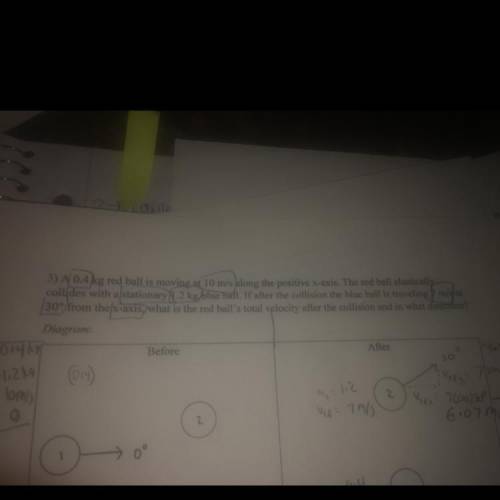
Physics, 06.03.2021 08:50, helpplz5725
A 0.4 kg red ball is moving at 10 m/s along the positive x axis. The red ball elastically collides with a stationary blue ball. If after the collision the blue ball is traveling 7 m/s at 30 degrees from the x-axis, what is the red balls total velocity after the collision and in what direction?


Answers: 2
Other questions on the subject: Physics

Physics, 21.06.2019 23:20, drice517
According to newton's second law, when the same force is applied to two objects of different masses, a the object with greater mass will experience a great acceleration, and the object with less mass will experience an even greater acceleration, b. the object with greater mass will experience a smaller acceleration, and the object with less mass will experience a greater acceleration, c. the object with greater mass will experience a greater acceleration, and the object with less mass will experience a smaller acceleration, d. the object with greater mass will experience a small acceleration, and the object with less mass will experience an even smaller acceleration.
Answers: 1

Physics, 22.06.2019 13:40, crayons18
An ideal otto cycle has a compression ratio of 10.5, takes in air at 90 kpa and 40°c, and is repeated 2500 times per minute. using constant specific heats at room temperature, determine the thermal efficiency of this cycle and the rate of heat input if the cycle is to produce 90 kw of power.
Answers: 2

Physics, 22.06.2019 20:10, dondre54
On a frictionless air track, a blue glider with mass 0.200 kg is moving to the right with a speed of 8.00 m/s. it strikes a red glider that has mass 0.600 kg and that is initially at rest. after the collision, the blue glider is moving to the left with a speed of 3.00 m/s.(a) what are the magnitude and direction of the velocity of the red glider after the collision? (b) is this collision elastic?
Answers: 1

Physics, 22.06.2019 21:40, lottie2306
Engines for propeller-driven aircraft are limited in their maximum rotational speed by the fact that the tip speed of the propeller must not approach the speed of sound in air (mach i). taking 6 ft as a typical diameter for a propeller of a light airplane and 1100 fils as the speed of sound, find the upper limit on the rpm (revolutions per minute) of the propeller shaft.
Answers: 3
Do you know the correct answer?
A 0.4 kg red ball is moving at 10 m/s along the positive x axis. The red ball elastically collides w...
Questions in other subjects:

Mathematics, 02.06.2021 23:30

Chemistry, 02.06.2021 23:30


Mathematics, 02.06.2021 23:30






Mathematics, 02.06.2021 23:30






